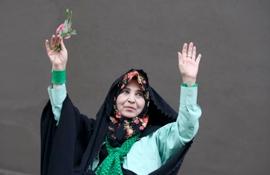
It is entirely appropriate that two women have become the iconic symbols of Iran’s protest movement. Thanks to cell phones and the Internet, millions of people around the world saw footage of the blood-soaked face of the young Neda Agha Soltan, as she lay dying on a Tehran street, shot by security forces during a peaceful demonstration. But even before last June’s rigged presidential election, Zahra Rahnavard, the wife of opposition candidate Mir Hussein Moussavi, had gained international renown as the first woman in Iranian history to campaign alongside her husband—making speeches of her own and taking a strong stand on controversial social issues.
Ms. Rahnavard has caused a stir, but also set an example. An author and educator in her own right, she was the first female chancellor of any Iranian university—she directed Alzahra University in Tehran from 1998 until 2006—and has served as a political advisor to former president Mohammed Khatami. During the campaign, she was outspoken in calling for reform and also courageously endorsed the demands of the One Million Signatures campaign, a women’s rights movement whose leaders have been attacked and arrested by the Iranian authorities.
Following her example, the wives of the other candidates began to appear on the campaign trail as well. Women were active in the campaigns of the two leading opposition presidential candidates; and when hundreds of thousands of protesters poured into the streets after Ahmadinejad was, improbably, declared the winner, women marched alongside the men, braving assaults and intimidation from the riot police, paramilitary forces, and knife-, club- and chain-wielding goons the government sent after the demonstrators. As an activist friend wryly told me, “They treated us equally. They beat, clubbed and arrested us just like the men.” (In a sign of the growing weight of the women’s vote, President Ahmadenijad—his legitimacy in serious doubt—sought to mollify this constituency by nominating three women to his cabinet, though parliament confirmed only one of them.)
Women have in fact been at the forefront of resistance to an intrusive state ever since the establishment of the Islamic Republic. In the early years of the revolution, they resisted the new regime’s attempt to force them out of the workplace and universities. They found subtle ways—such as showing a bit of hair and wearing shorter robes in pastel colors—of challenging the restrictive dress code the government imposed on them in the name of Islam. They refused to stay segregated, whether in the university classroom or in taxis. Today, more women than men win admission to universities in competitive state-wide examinations, and this trend has so alarmed some members of parliament in recent years that there has been talk of legislation to impose quotas: affirmative action in the interest of men!
In the mid-1990s, women flocked to support the reform-minded administration of President Mohammad Khatami, accounting for, in part, the large majorities by which he won his two terms in office. With the One Million Signatures campaign, launched in 2006 and aimed at collecting a million signatures for a petition protesting discriminatory legislation against women, the women’s movement entered a new phase, implicitly calling for a revision of laws rooted in the basic principles of Islam. Arrest, trial, heavy fines, and imprisonment have not deterred the leaders of this campaign, who come mostly from the broad middle class and have gone to small towns and villages as well as the large cities to collect signatures.
The participation by women in the latest series of protests marks another notable development. Women have shown themselves ready to do what had generally been regarded as ‘men’s work.” Despite the risk of beatings, injury, arrest, even death, they have continued to take a leading part in protests and demonstrations. The demonstrators’ chant, “we are men of war,” has changed to “we are men and women of war.”
When I was held in solitary confinement in Tehran’s Evin Prison in 2007, I was questioned at length about the women’s rights movement; my two interrogators seemed alarmed and befuddled by it. They certainly feared its potential: how else to explain the harsh way in which officials have dealt with the women collecting signatures for a simple petition? But my interrogators also told me they feared a backlash if they used excessive force to disperse female demonstrators.
That was three years ago. Now, the gloves are off. The sight of tens of thousands of women marching alongside men in demonstrations last June seems to have unnerved the authorities. Under the increasingly brutal regime of Ahmadinejad’s second term, Iranians have seen young and middle-aged women clubbed, dragged across pavements, and hustled into vans by police and official thugs in plain clothes. Rahnavard has steadfastly condemned the brutality of the security forces.
Advertisement
Only last week, mothers of young men and women who have disappeared in prisons or other government black holes, and who have been gathering every Saturday in a Tehran park to demand news of their loved ones, were beaten and arrested by security men. They have since been released but some may be asked to appear in court. Such scenes are now seared into the memories of Iranians; they will come back to haunt the regime for years to come.


